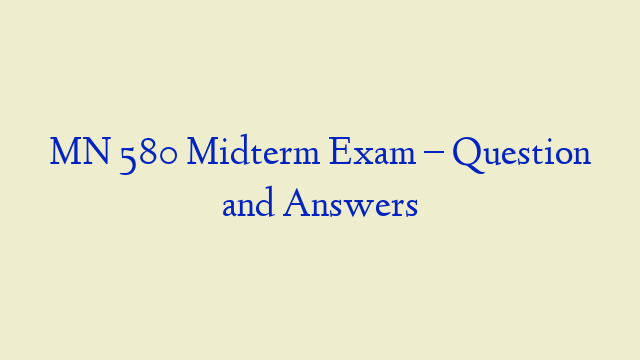Description
MN 580 Midterm Exam – Question with Answers
- An 18-year-old man presents with periumbilical pain, vomiting, and abdominal cramping over the past 48 hours. Physical examination reveals rebound tenderness and laboratory analysis shows the presence of bandemia and a total WBC of 28,000 mm3. To support the diagnosis of acute appendicitis with suspected appendiceal rupture, you consider obtaining the following abdominal imaging study:
- Gina is 2 years old and presents with a 3-day history of fever, crankiness, and congested cough. Her respiratory rate is more than 50% of the upper limits of normal for age. Tubular breath sounds are noted at the right lung base. Skin turgor is normal, and she is wearing a wet diaper. She is alert, resisting the examination as age appropriate, and engages in eye contact. Temperature is 38.3° C (101° F). Gina’s diagnostic evaluation should include:
- Aortic stenosis in a 15-year-old male is most likely:
- Which of the following laboratory tests can identify the causative organism of bronchiolitis?
- A Still murmur:
- A physiological murmur has which of the following characteristics?
- You anticipate that adult car seat belts fit correctly when a child is approximately _____ tall and is____ old.
- Physical examination findings in otitis externa include:
- In infants, solid foods are best introduced no earlier than:
- When advising a patient about injectable influenza immunization, the nurse practitioner (NP) considers the following about the use of this vaccine:
- A healthy 2-year-old child is able to:
- The preferred treatment option for a 6-year-old boy with pertussis is:
- At which of the following ages in a young child’s life is parental anticipatory guidance about using “time out” as a discipline method most helpful?
- Common causative organisms of acute suppurative conjunctivitis include all of the following except:
- At which of the following ages in a young child’s life is parental anticipatory guidance about protection from falls most helpful?
- Which of the following statements is true about inactivated poliovirus vaccine (IPV)?
- Problems after tetanus immunization typically include:
- Which of the following is true about the MMR vaccine?
- Treatment of viral conjunctivitis can include:
- A healthy 6–7-month-old infant is able to:
- At which of the following ages in a young child’s life is parental anticipatory guidance about temper tantrums most helpful?
- Which of the following findings is most consistent with the diagnosis of acute bacterial rhinosinusitis (ABRS)?
- Which of the following is the most prudent first-line treatment choice for an otherwise well toddler with acute otitis media (AOM) who requires antimicrobial therapy?
- Which of the following is one of the more common sources of hepatitis A infection in the United States?
- Juice intake is acceptable in children 6 months and older per which of the following recommendations? Select all that apply.
- You are examining an 18-year-old man who is seeking a sports clearance physical examination. You note a mid-systolic murmur that gets louder when he stands. This may represent:
- A healthy infant at age 9–11 months is expected to:
- You examine a 10-year-old boy with suspected streptococcal pharyngitis. His mother asks if he can get a “shot of penicillin.” Which of the following statements is/are true regarding the use of intramuscular (IM) penicillin? Select all that apply.
- At which of the following ages in an infant’s life is parental anticipatory guidance about teething most helpful?
- First-line treatment for uncomplicated hordeolum is:
- Which of the following imaging studies potentially exposes the patient being evaluated for abdominal pain to the lowest ionizing radiation burden?
- You are examining an 18-month-old boy who is not speaking any discernible words. Mom tells you he has not said “mama or dada” yet or babbled or smiled responsively. You:
- The gastric parietal cells produce:
- The most common causative organism of bronchiolitis is:
- Which of the following would not be found in newborns?

